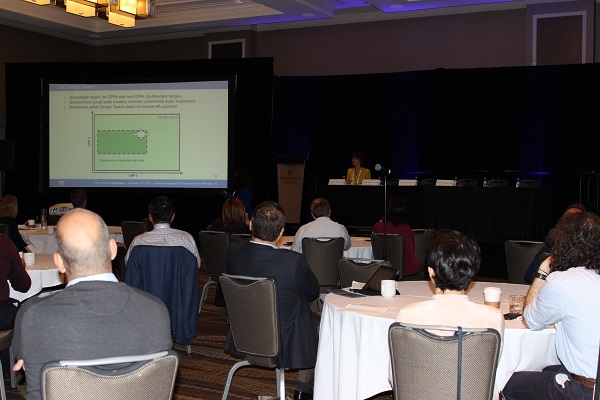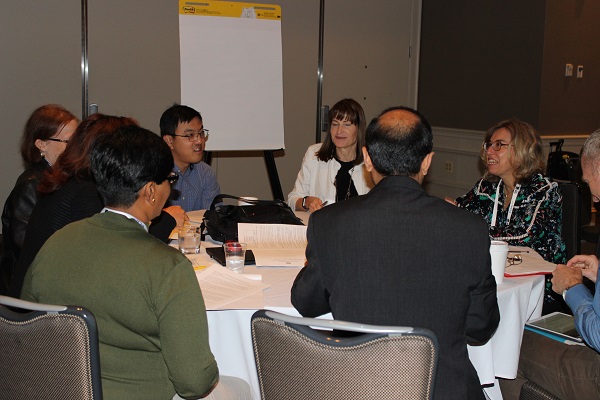PDA and IFPMA Foster Discussion on PAC
Global regulatory harmonization and expanded reliance on pharmaceutical quality systems (PQS) within companies will be key to reducing the complexity around post-approval changes (PAC), according to several speakers at the 2017 PDA PAC iAM Workshop, Sept. 13–14, following the 2017 PDA/FDA Joint Regulatory Conference.

The workshop was co-sponsored by the International Federation of Pharmaceutical Manufacturers and Associations (IFPMA). Chaired by Ursula Busse, PhD, Head, Quality Intelligence and External Relations, Novartis, and Lisa Skeens, PhD, Vice President, Global Regulatory Affairs, Pfizer, the workshop provided insights into several international initiatives such as ICH Q12: Technical and Regulatory Considerations for Pharmaceutical Product Lifecycle Management, touched on practical aspects of PAC implementation and provided an overview of the PDA PAC iAMSM task force’s current work. It reflected the most current thinking on the concepts and tools proposed to facilitate PAC and spur manufacturing innovation during a product’s commercial phase. Participants actively engaged in discussion and were also given an opportunity to provide responses to survey questions in real time using their personal mobile devices during the meeting.
In recent years, both ICH and WHO have launched several worldwide initiatives to address the issue of PAC, with support from both PDA and IFPMA. The lack of a harmonized global regulatory framework for PAC leads to supply chain complexity, slows down the pace of manufacturing innovation and increases the risk of quality failures.
In the opening plenary session of the workshop, Anders Vinther, PhD, Chief Quality Officer, Sanofi Pasteur, and co-chair of the PDA PAC iAMSM task force, called for a global dialogue between industry and regulators to resolve current PAC regulatory challenges. Bob Iser, Director, Office of Process and Facilities, CDER, FDA, and member of the ICH Expert Working Group (EWG) responsible for ICH Q12, mentioned that ongoing dialogue within the group has already paved the way for closer alignment among different regulatory agencies, including new ICH member organizations. He emphasized that implementation of ICH Q12 principles, not the document alone, will improve the situation. Isabelle Colmagne-Poulard, Senior Director, Regulatory CMC Strategic and Technical Advisor, Global Regulatory Affairs and Quality Assurance, Merck KGaA, then spoke on behalf of IFPMA about international initiatives complementary to ICH’s science- and risk-based dialogue around PAC. In particular, she cited the WHO's efforts in strengthening national regulatory systems while striving for global regulatory convergence. And she highlighted reliance on a company’s pharmaceutical quality system (PQS) to manage low-risk changes to reduce regulatory reporting burden.
The next two plenary sessions then delved into some of the principles and tools proposed by ICH Q12. Frank Montgomery, Global Head, Regulatory CMC, AstraZeneca, and member of the ICH Q12 EWG, spoke about Established Conditions (ECs) and change categorization, as well as the anticipated benefits of ECs and how to realize them. Iser provided the regulator’s point of view. Both outlined how the risk- and science-based approach of the EC concept will reduce the amount of information that needs to be assessed by a regulator. They also underscored the importance of sound knowledge management, as reporting categories for changes will be linked to the level of product and process understanding. A real-time survey of attendees during the session showed that some companies are already applying the EC concept to their PAC management, and that most see the value of leveraging it universally.
The next day, Emma Ramnarine, Senior Director Global Biologics, Genentech Roche, and co-chair of the PDA PAC iAMSM task force, provided insights into the dynamics of the product lifecycle. She pointed to her company’s Post-Approval Lifecycle Management plan as an example. Mahesh Ramanadham, PharmD, Acting Director of the Division of Inspection Assessment, CDER, FDA, and member of the ICH Q12 EWG, introduced the Product Lifecycle Management document as an effective tool to be used for communication between a company and regulatory agencies and, within an agency, between assessors and inspectors. Both touched on the importance of establishing an effective PQS and sharing knowledge between industry and regulatory agencies to reduce PAC notification requirements.
In addition to these presentations, attendees also broke into groups to discuss case studies. Here, participants explored concepts proposed by ICH Q12 to better manage PAC and then applied the science- and risk-based approaches cited by the speakers. ECs, change categorization and reporting categories in the context of a company’s PQS were discussed in different roundtable settings. Participants also provided feedback to the PDA technical report team currently developing a document centered on PAC change management protocols (PACMP) as a potential solution to PAC complexity. These interactive activities showed that participants clearly prioritize knowledge management and quality risk management in their change management systems to gain regulatory flexibility.

Following these roundtable discussions, the closing panel provided insights on initiatives in manufacturing innovation and global solutions aimed at resolving PAC regulatory complexity. Morten Munk, Global Technology Partner, NNE, spoke on behalf of PDA’s Aging Facilities Task Force on the challenges encountered by the current PAC regulatory environment, which slows down the rate of manufacturing innovation. Sharmista Chatterjee, Division Director, Division of Process Assessment, FDA, explained the FDA Emerging Technology Team’s role in encouraging the adoption of novel manufacturing technologies. She said that information exchange between regulatory authorities can enable faster adoption of innovative technologies in other regions. Susanne Martz, PhD, Senior Vice President of Quality Vaccines, GSK Vaccines, and member of IFPMA’s Vaccines Heads of Quality Group, outlined the quality group’s ongoing work to advocate for streamlined and more predictable global PAC approvals. Their efforts are geared toward reducing the rate of vaccine shortages, currently, a major worldwide healthcare issue.
The workshop turned out to be highly interactive as panelists and speakers addressed myriad questions. The presentations showed that ICH Q12, once appropriately implemented, should increase opportunities to make changes without prior approval, benefitting both industry and regulators alike. This should incentivize manufacturers to invest in product lifecycle management and PQS. All global efforts combined should foster regulatory harmonization of PAC regulations, encourage adoption of shared principles and facilitate continual improvement to spur manufacturing innovation globally.
Did the workshop change participants’ opinions about current initiatives and their impact on PAC management? Yes and no, according to the real-time surveys: Views about effect of these initiatives on the current situation did not change: 75% of respondents still believed the initiatives would have a favorable impact, while 25% felt that PAC management will just be different. Participants also highlighted two additional critical success factors for these initiatives, in addition to trust, harmonization and dialogue: courage and examples to share across industry. Ultimately, PDA plans to support standardization across industry and implementation of shared principles.
The workshop underscored the strong link between an effective PQS and successful lifecycle management. It showed that companies can gain regulatory flexibility in PAC management if they apply the principles of ICH Q8–11. A sound scientific understanding of products and processes, coupled with consistent application of quality risk management, embedded in an effective PQS, will provide the basis for ICH Q12 realization.


